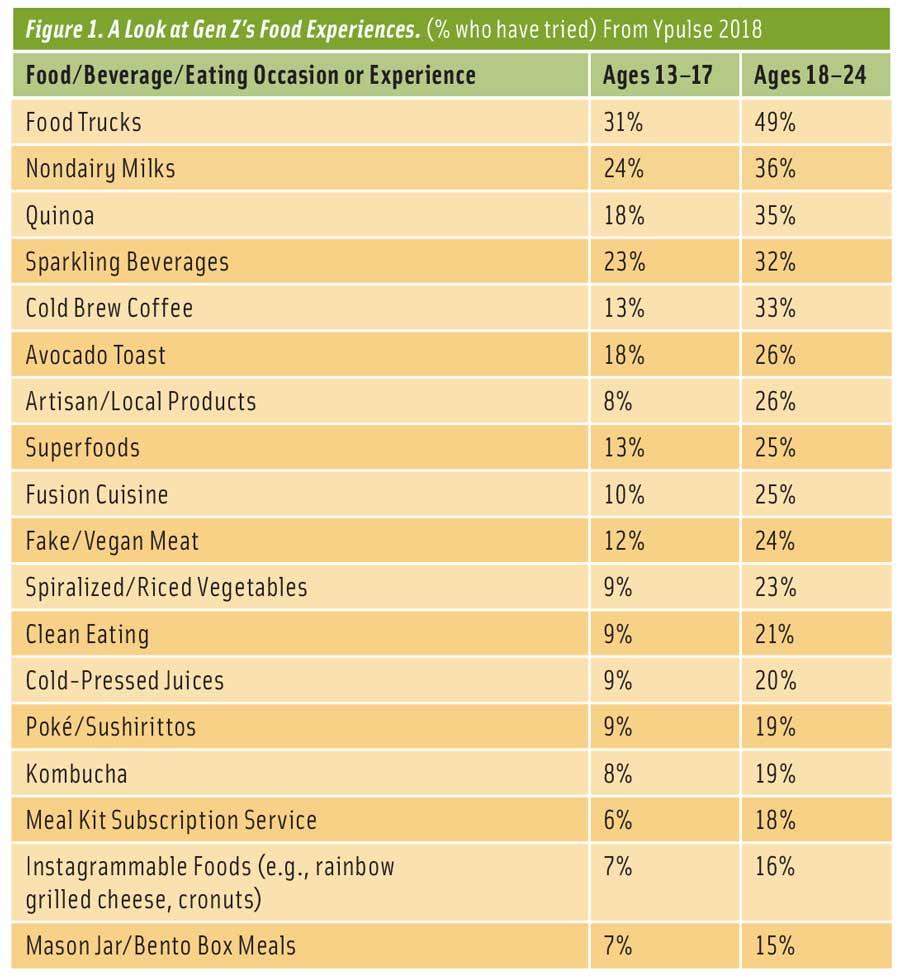The ABCs of Generation Z
CONSUMER TRENDS
 Influenced by their “foodie” Gen X and older Millennial parents and school programs aimed at healthier eating and preserving our planet, members of Gen Z are beginning to make their mark on the food/beverage industry.
Influenced by their “foodie” Gen X and older Millennial parents and school programs aimed at healthier eating and preserving our planet, members of Gen Z are beginning to make their mark on the food/beverage industry.
While there is no formal U.S. Census Bureau definition, Gen Z is most commonly described as being between the ages of 11 and 23, representing 27% of the U.S. population or 64 million Americans in 2018, making it the largest generational cohort. (Standard data collection approaches use the age range of 18 to 24, so please note that some references to older members of the Gen Z demographic in this column use that age range.)
Despite the fact that they spend more on food and beverages than any other population segment, according to Packaged Facts’ Looking Ahead to Gen Z report, most Gen Zers have yet to become full-fledged consumers. Just about half (48%) of those aged 18–24 still live in their parents’ home; 41% of those in this age group were in college in 2017.
According to Ypulse’s 2018 Food and Shopping Trends Survey, 40% of teens aged 13–17 and 79% of older Gen Zers say they do some of the food preparation in their household; 27% and 65%, respectively, have an impact on at least half of the groceries purchased.
Older Gen Zers (18–24) had a mean annual income of $20,000 in 2017; those aged 13–17, $4,200. Seventy-one percent of those aged 18–24 work at least part-time, per Packaged Facts.
With one-third of Gen Z growing up in a single-parent household and witnessing the recession of 2008 and experiencing relatively high unemployment as well as high college debt, it’s not surprising that they are more pragmatic and value-driven than Millennials, Packaged Facts reports.
Gen Z is the most digitally connected, ethnically diverse, globally aware, and visually oriented generation to date. Ypulse reports that 42% of teens and half of older Gen Zers define themselves as a foodie. Moreover, the population segment composed of those aged 18–24 now has the highest proportion of gourmet specialty foods users, per the Specialty Food Association’s 2018 State-of-the-Specialty Food Industry report.
Nearly half (45%) of older Gen Zers watch online food videos often or very often, 42% frequently watch cooking shows, 40% bake often or very often, and 35% frequently post pictures of food on social media, per Ypulse. Nearly half of older Gen Zers have purchased food from a food truck, according to Ypulse statistics.
Sweet flavors lead the list of flavor preferences for members of Gen Z versus savory, which leads among the population overall. Fruity, smoky, spicy, bold, salty, tangy, herbal, and sour flavors are significantly more appealing to Gen Z versus adults overall, according to Technomic’s 2017 Flavor Consumer Trend Report.
Gen Z continues to drive interest in ethnic fusion and less familiar cuisines: 48% of those aged 18–24 are very interested in Mediterranean cuisine, 46% are very interested in Japanese/sushi, and 39% are very interested in Thai/Vietnamese, per FMI’s 2018 Power of Foodservice at Retail Report. Ethnic breakfast, lunch, and snack products are missed opportunities with Gen Z.
After price, cooking instructions/need for a recipe, nutrition information, and how easy something is to prepare are the greatest influences on Gen Z’s willingness to buy a food product, according to Ypulse. The NPD Group’s 2018 Make It Happen for Gen Z report states that 58% of Gen Z meals were made without an appliance compared with 46% of meals prepared that way by Millennials.
Teens are twice as likely as any other population group to eat frozen meals/entrées, per Packaged Facts’ 2017 Frozen Foods in the U.S. report. Fresh prepared foods, restaurant take-out/delivery, precooked meats, oven- or microwave-ready packaging, and meals kits are of high importance to Gen Z.
Chicken is by far the most popular dinner entrée eaten by members of Gen Z on a typical weekday, followed by pasta, pizza, vegetables, beef, rice, burgers, and salad, per Ypulse. One-third eat Mexican food, one-quarter have ramen/soba noodles, and one in five enjoy barbecue.
While sandwiches, pizza, chicken, pasta, and salads are the most popular lunch items for Gen Z, older Gen Zers eat salads, pasta, burgers, beef, rice, soup, and frozen prepared foods more frequently than teens, per Ypulse. Coffee, breakfast sandwiches, yogurt, smoothies/protein shakes, and granola are consumed more frequently at breakfast by those aged 18–24 than by teens, reports Ypulse.
Gen Z is driving a new early morning snacking occasion, according to IRI’s 2016 State-of the Snack Food Industry; 52% of those aged 18–24 and 45% of teens snack before breakfast.
Members of Gen Z are also among the heaviest users of alternative snacks, per Packaged Facts’ 2017 Snack Food Nutrition Trends: Pulses, Vegetables, and Grains report. Four in 10 eat snacks made with chickpeas, lentils, beans, peas, and the like; one-third opt for snacks made with ancient grains; and 28% have snacks that contain seaweed.
Sales of fresh snack packs, which are very popular with Gen Z, jumped 45% in 2017, according to IRI’s 2017 State-of-the-Snack Food Industry report. Fruit, cookies, chips, crackers, cheese, and candy/sweets are the most popular Gen Z snacks, per Ypulse. Fruit, trail mixes, and jerky are posting strong gains, according to Packaged Facts.
When it comes to beverages, it is all about water, specialty drinks, and functional beverages. Water, coffee, juice, soda, tea, and milk are the beverages that are most consumed by members of Gen Z, although the order differs by age.
Beverages that are trending among college students include coconut water, alkaline waters, cold brew coffee, kombucha, protein drinks, liquid water enhancers, and green/cold-pressed smoothies, according to Beverage Marketing Corp.’s 2018 College Student Beverage Consumption and Attitudes U.S. report.
All natural, organic, local, and GMO-free are among the top claims that make one-third of Gen Z more willing to purchase a food or beverage, per Ypulse. Preservative-free, sugar-free, and fair trade descriptors also prompt purchases.
Nine in 10 Gen Zers want to add more plant-based foods to their diet, according to Culinary Visions Panel’s 2018 Ethnics on the Go report. A vegan claim enhances appeal for 29% of Gen Z consumers, per the Culinary Visions Panel data.
About half of the members of Gen Z are experimenting with diet/eating plans. They use them intermittently, however, and sometimes switch regimens throughout the same day. Just over one-quarter of those aged 18–24 have tried the Paleo diet; 24% have done the Whole 30 diet; and 13% have tried intermittent fasting, according to the International Food Information Council’s 2018 Food & Nutrition Survey. Six percent have tried a vegetarian or vegan diet.
One-third of those aged 2–19 are overweight and 17% are obese, according to data from the Centers for Disease Control & Prevention. Not surprisingly, the top health concerns of Gen Z are focused on everyday performance and looking/feeling good; stress, tiredness/lack of energy, muscle tone, mental sharpness, sleep, back/neck pain, and skin health are among the top concerns, per the 2016 HealthFocus U.S. Consumer Survey.
With 46% of those aged 14–17 exercising regularly and 38% of those aged age 18–24 doing so, according to IRI’s Gen Z: the Next Zeneration of Influencers for Brands and Retailers report, Gen Z is helping to drive the $42 billion sports nutrition market mainstream.
One-third of older Gen Zers use protein powders, drinks, or bars; 23%, energy drinks; 14%, hydration drinks; 12%, creatine; and 11%, amino acids, according to the 2017 Consumer Supplement Survey conducted by the Council for Responsible Nutrition (CRN).
Gen Zers are strong proponents of herbs/botanicals; 24% use green tea supplements; 13%, cranberry; 9%, ginseng, garlic, or echinacea; and 6%, turmeric or gingko biloba, per CRN.
Lastly, digestive issues are important for members of Gen Z. Just over six in 10 of those aged 18–24 suffer from indigestion, gas/bloating, diarrhea, or constipation every year, according to Mintel’s 2016 Digestive Health—U.S. report. Fiber, probiotics, and digestive enzymes are among the top five most used specialty supplements by Gen Z, per CRN.
 A. Elizabeth Sloan, PhD, Contributing Editor
A. Elizabeth Sloan, PhD, Contributing Editor
President, Sloan Trends Inc., Escondido, Calif.
[email protected]


